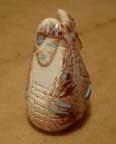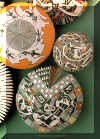| Barrie Lawrence
was born in British
Columbia and has lived on the Pacific Northwest coast all his
life. Self-taught, he began carving in the 1960's in the Tsimshian
style to honor his Grandmother. By the late 1970's he was carving
plaques, paddles and other primarily two dimensional surface
carvings for commercial purposes. His work was displayed and sold
in several shops and galleries including the Royal British
Columbia Museum Gift Shop, Arts of the Raven Gallery, the Indian
Craft Shop, the Nootkan Bear and the Wounded Knee Gallery in
Beverly Hills, California.
His career and time
commitments virtually precluded the opportunity to carve until his
retirement from B.C. Telephone in 1993. In 1994, Barrie began
working at Cutter's Tools in Victoria, B.C. selling carving
supplies and teaching carving. It was this exposure to really
first class carving tools and the techniques for maintaining them
that quickly expanded his carving range to deep carving items such
as bowls, masks and other three dimensional sculpture. |



|
| Ed
Lementino is a talented and versatile Zuni fetish
carver who carves a variety of figures and animals, but is best
known for his Zuni Corn Maidens. Ed likes traditional work, but
gives his pieces an occasional contemporary look and feel! Ed
prefers to carve in turquoise and malachite, but also uses a lot
of mother of pearl shell with his Maidens. |

|
|
Gary Leon
was born in Mission, B.C., and
raised nearby on the Chehalis Reserve. He has always had a love of art. In
1991, on the basis of the work he had already produced, he was accepted
for study and training at the Kitanmaax Northwest Coast Indian Art School,
also known as "Ksan", in Hazelton, B.C.
Gary graduated from the four-year
course in April 1995. His wife, Pam, is very much a part of his work and
runs the business end of it. They are proud parents of two young girls. In
the fall of 1995 they moved to Williams Lake, where Gary teaches Native
Art.
|

|
| The Lewis
Sisters This Acoma
family is known for its use of natural clay and colorful paints
including pink, orange, green, blue, brown and gray. The oldest
sister, Rebecca Lucario, learned the art of pottery from her
grandmother. Her finely painted seed jars, ollas and miniature
pieces have won numerous awards for their artistry and detail.
Diane Lewis and Carolyn Concho both make seed pots, often
including images of animals and other traditional mimbres designs.
Bernard and Sharon Lewis are best known for their seed jars and
pots, which often have snakes peeking out. |

|
| Philip
Lightbear & Joanna Moonflower, Abenaki of Porcupine Designs
offers jewelry, traditional rattles, bowls, pollen bottles and
talking sticks |

|
| Melody Lightfeather,
a member of the
Southwestern Pima tribe, is one of today's most prominent Native
American artists. Her early watercolors won international contests
and were displayed in the Louvre. The range of her creative
abilities is clearly shown by winning the Silver Poet Laureate
Award at the 1989 National Poetry Competition. Her magnificent
works of art grace many prominent galleries, museums, and
corporate offices. She created some 600 original paintings on
Native American and Southwestern history for a single client, the
largest commission executed by an individual artist in this
century. |

|
| Nancy
Youngblood Lugo As a
child, Nancy's military father gave the family a cosmopolitan
background by traveling through Europe and living in The
Netherlands. At age 12, Nancy retured to the pueblo where she
began to watch her grandmothers work. This was her primary
tutorial in what was to become her calling -- traditional Santa
Clara pottery.
As Nancy reflects on the early
days of her learning, the messages were clear: To be a potter was
to uphold the Santa Clara tradition. To do it right was to embrace
tradition using "the old ways."
|
 |
- Jason
Lujan, This Chiracahua Apache artist devises images and narratives
that fold back on themselves, splitting meaning and reference, but
always using signifiers that shift to capture an American Indian
perspective. The desire is to produce work that is in some sort
of ideological motion, moving within and subverting the rhetorical
forms of European and American Indian artistic properties; a process
in which standard meanings are used to create new ones bearing
different resonances for Indian and non-Indian audiences alike.
|

|
|
|
|

